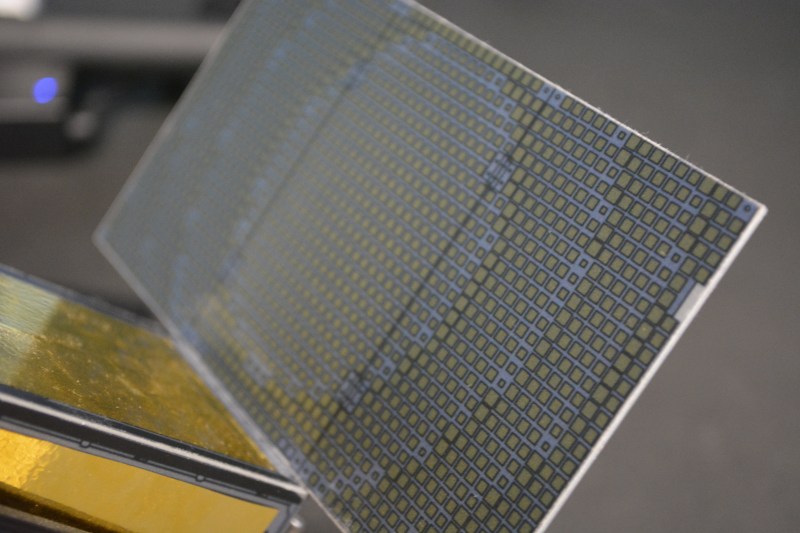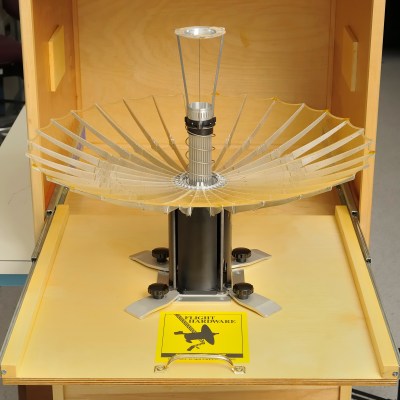You have a shoe box sized computer that you want to use in a Mars fly by. How do you communicate with it? The answer is a very clever set of antennas. I got to sit down with Nacer Chahat, one of the engineers on the Jet Propulsion Laboratory team responsible for antenna design on Mars Cube One (MarCO). Two of these CubeSats that will soon be used to help a lander reach Mars. We talked about the work that went into MarCO, the deployable radar antenna he’s worked on for the RainCube project, and the early progress on OMERA, the One Meter Reflectarray.
This is a fascinating discussion of dealing with a multitude of engineering challenges including lack of available space for the antenna components, and power and weight limitations. Check out the video interview to see how the people at JPL fit it all into this, and other tiny satellites, then join us below for more details.
Bent Pipe Communications

It is difficult for vehicles on the surface of Mars to communicate directly with Earth, but much easier for satellites in Mars orbit to do so. There is already one large satellite orbiting the planet, the Mars Reconnaissance Orbiter (MRO) which entered orbit in 2006. It is in contact with Earth but sometimes doesn’t have line of sight because it is behind Mars. This means windows of time when communications are not available.
NASA plans to launch InSight — a lander that will dig below the surface of the red planet — in 2018. Two 6U CubeSats will be along for the ride, separating from the rest of the payload as they approach Mars. These satellites will communicate with InSight during entry descent and landing on UHF, and communicate back to Earth on X-band. This is an important because the MRO will be behind Mars during that time, unable to perform this task.
The ‘Bent Pipe’ refers to the ability of these CubeSats to be in contact with both the lander and Earth, relaying data in real time at the same rate it is received from the lander. Once the lander has touched down the MarCO satellites will have performed their task and will fly by the planet, but will not enter orbit.
This is a fascinating development for several reasons. Currently, the MRO is capable of both UHF and X-band communications but not at the same time. The CubeSats, which are cheaper and faster to build, can communicate on both bands at the same time and will provide the data relay during InSight’s EDL.
A Very Small Target a Very Long Distance Away
On average, Mars is about 225,000,000 kilometers away from earth. The communication link JPL is building between the two is the size of a shoebox. A 6U CubeSat measures about 10x20x30 cm. This is an incredible engineering challenge. The satellites need to be self sufficient, able to orient themselves correctly, be able to survive the trip from one planet to another, and have the radio equipment necessary to communicate over that distance. This is where the team Nacer works with comes into the picture.
Antenna engineers and mechanical engineers work together with the rest of the CubeSat teams to design and build the communications array. In this case, a brand new radio called IRIS was developed to help meet the power and size constraints. There almost no room inside the vehicle left for an antenna array so the reflectors were built to fold flat on the outside of the vehicle. The UHF antenna, which communicates with the Mars ground vehicles, sits flat on the bottom of the satellite but pops out like a jack-in-the-box.
 The X-band antenna that transmits back to earth folds into three panels. When deployed, the reflector array is wider than it is tall so the signal source also has an array to utilize the full reflector. Interestingly, the pattern you can see on the reflector array helps the flat panels act more like a parabolic reflector. MarCO is also capable of receiving X-band from Earth using the array seen on the front face of the folded model above. These CubeSats are unable to transmit on the UHF band, they only receive the UHF communications from ground vehicles.
The X-band antenna that transmits back to earth folds into three panels. When deployed, the reflector array is wider than it is tall so the signal source also has an array to utilize the full reflector. Interestingly, the pattern you can see on the reflector array helps the flat panels act more like a parabolic reflector. MarCO is also capable of receiving X-band from Earth using the array seen on the front face of the folded model above. These CubeSats are unable to transmit on the UHF band, they only receive the UHF communications from ground vehicles.

Bigger Reflectors, Same 6U Form Factor

I originally met Nacer after I toured NASA’s Jet Propulsion Laboratory back in December. I had marveled at the deployable antenna for SMAP — a full sized satellite — and he contacted me to mention how awesome deployables are in these CubeSats. He wasn’t kidding. He has also worked on the RainCube project which will orbit earth collecting precipitation data using radar.
RainCube includes a 0.5 meter parabolic reflector for Ka-band operation. The reflector still needs to fit inside the 10x20x30 cm satellite. Specifically, the design team was allotted a 10x10x15 centimeter storage area for the reflector and the arm that holds the subreflector.
The result is this fantastic two-stage parabolic reflector which extends out of the canister at one end of the CubeSat and then unfolds a second stage. The subreflector arm then pops out to the appropriate position, about 0.24 meters from the main reflector. A demonstration of the deployment is shown during the video interview.
You Call That a Challenge?

It seems that a half-meter reflector isn’t a big enough challenge for the JPL team. They are now working on a project called OMERA. I could find very little information available for this project so I am happy that Nacer was able to share. This acronym stands for the One Meter Reflectarray, a square reflector that measures one meter on each side.
The team has just finished building a fixed model of the reflector design and you can see Nacer posing with the OMERA prototype in one of JPL’s anechoic chambers. This prototype doesn’t fold, but having proven the RF properties of the system the next step is for the mechanical engineers to add hinges to the fifteen panels and develop a deployment system. The feed for this reflector array needs to extend about 0.7 meters from the array which is itself no small feat. This operates on the Ka-band so the surface accuracy is much less forgiving than with X-band communications.
The work going into these CubeSats is fantastic! It’s amazing to see both the constraints that these engineers face and their solutions. The programs cost less to see through than ever before, which we hope means more hardware in less time. It also has the effect of energizing the engineers like Nacer who work on these programs as everywhere you turn there is a new and exciting challenge to take on.
If you’re part of your own awesome engineering project we’d love to talk to you too. Make sure to let us know what you’re up to by contacting us on the Hackaday Tips Line.


















Antennas, insects have antennae
Oh drat, I even looked up the plural of antenna but didn’t realize the distinction. Thanks, I’ve updated the title.
Good grief don’t worry about, much less than get dragged in to silly technical grammar semantics by a smarter than thee statement. Use antennas at some point you are likely to come across some one who would bust you for not using antennae, as I said, silly. Liked the interview. Please try to find someone to interview than can speak with authority on fractal antennas. Many self described experts seem to confuse the issue, particularly when it comes to UHF TV antennas.
A pyramid without any purpose behind the interviewers. Illuminati confirmed, deploy the tin hat!
The First photo is also in the style of a wedding photo
Wow very cool piece of hardware!! Looking forward to seeing these spacecraft flying…
“These satellites will communicate with InSight during entry descent and landing on UHF, and communicate back to Earth on X-band. This is an important because the MRO will be behind Mars during that time, unable to perform this task.”
There must be more to this…
Couldn’t they adjust the launch time, or change the cruise velocity, such that MRO is both visible to InSight and Earth during Mars entry descent and landing?
I didn’t ask specifically when I was talking with Nacer. But my understanding is that MRO can’t communicate on UHF and X-Band at the same time. So it would have to collect data from InSight during EDL and then relay it back to Earth afterwards, otherwise it risks missing data transmitted from the lander.
Also, I would think they scheduled a time when MRO is on the other side of the planet so they don’t risk hitting it if something goes wrong during the approach. This is my own conjecture.
It is already not real time, since the X minute communications lag from Mars…
So you don’t need the data back real time.
I bet it is a memory buffer size problem.
MRO probably does not have a large enough memory buffer to store all the real time data from InSight during entry descent and landing, for later transmission back to Earth.
And they would not want to store the data on InSight, for later broadcast, (it might make make a new crater on Mars). ;)
Or they don’t want to rely on MRO still functioning (11+ years old) for the entry descent and landing relay.
The problem is that MRO cannot collect InSight relay data on UHF and transmit it on X-band at the same time. InSight will be in view of the Earth during EDL – several radiotelescopes will be able to detect the UHF signal. MRO will be on the Earth side of Mars. It will collect a very detailed recording of the InSight relay data, and transmit it to the ground after InSight lands.
Not to flame bait but I hope the near earth satellite doesn’t get defunded by Agent Orange. I heard he does not like NASA to study climate change
lmao!
good point.
NOAA is in charge of weather research. I think your point still sticks. Agent Orange (lol) is raining grief on many government agencies.
He is big on return to the Moon. For many practical reasons, I would take that over Mars any day.
According to the ‘My Favorite Martian’ documentary series in the 1960’s, Martians have built in antennas. Why not copy those?
Not a Hack.
This is the real thing. Different word used….
Engineering. See also: competent
Good interview. The folding aspect of the antenna reminded me of something I just watched on PBS about “origami revolution”. They had a bit or two about unfolding antennas in space. That is also well worth a watch.
I don’t know if the video got to this, I just skipped through and couldn’t find an explanation of the mechanism by which the flat reflector works like a parabolic reflector.
After a bit of research it turns out that’s what’s called a shaped reflectarray. Basically an 2 surface of antenna structures without feeds for your target frequency. In this imeplementation they use a patch antenna for the resonant elements. By changing the size of the patch antenna to a bit above or a bit below it’s proper size at the target frequency the time it takes for reflection changes slightly. This causes the phase of the reflected radio wave to be controllable based on the size and placement of the patch antenna resonator elements. So they arrange them to match what the phase would be in a 2D slice of the beam output in front of a dish antenna. Because of this the reflection from the reflectarray has a pattern that acts like a dish antenna at that exact frequency. Here’s an plot from “Reflectarray Antennas: Analysis, Design, Fabrication, and Measurement” showing the sigmoid response curve of patch size vs phase shift: http://superkuh.com/patch-reflectarray-reflected-phase-shift-vs-patch-side-length.png
Pretty cool stuff. It has a much better aperture efficiency then flat refracting lenses like zone plates. But on the downside there are significant dielectric losses from the patch resonators on the dielectric. If they didn’t use dielectric then they patch elements would need to be much larger.
typo fix: Basically a *2D* surface of antenna structures without feeds for your target frequency.
This is exactly the comment I was looking for. I thought the antenna was super interesting, and it seems do behave in the way I expected it to. Really cool!
Thanks for checking into that. The Fresnel look of the patches implied a phase shift and I thought it might have something to do with the thickness of the PCB. Pretty dang interesting!
This was an interesting, enjoyed it.
However one always wondered with the mini sats why no one has gone the Mini/Micro Sat’s anchored to stable bodies like asteroids creating a sort of Mesh network. As they are so cheap they could be sent out in multipuls and just solar power them. Just curious.
Well, the hardware needed for that work wouldn’t be cheap.
To date, nearly all nano-satellites (1-10kg) have been deployed within the Van Allen belt, and thus, shielded from most cosmic radiation by the earth’s magnetic field. Commercial/Industrial MCUs can handle the occasional SEU of LEO, but total ionizing dose over any period of time in deep space is likely to fry them within weeks.
To design a craft to exist in deep space, it’d need exponentially more expensive hardware. Not to mention, the most expensive part of a satellite, with the exception of a rare science payload, is the triple junction solar panels. Further distance requires more tx power, which requires more power generation capability.
Then on top of that, a mission such as you mentioned would require active attitude determination and control for proper pointing back to earth for transmission. Yet more size, more power, an expensive star tracker for attitude information, and more radiation hardened components to handle the state calculation and output control signals to reaction wheels that have a limited life span themselves.
Cubesats are awesome. I’ve loved my time working on them and can’t wait to see what awesome stuff like these guys at JPL are capable of in the future. That being said, as of now, the COTS available hardware is not ready for anything outside of LEO that’s of any type of extended duration mission.
Cheap compared to large spacecrafts. It is obviously relative.
Up until recently you’d be right, but the Iris v2 radio systems developed for the cubesats in this very article are novel in that they support 2 different doppler and 1 ranging modes and are able to support positioning and navigation in deep space outside of GPS operational sphere. The Iris principle researcher, Courtney Duncans has a few presentations she gave to the JPL amateur radio club on this issue that cover it in detail. It sounds like the DSN people are interested in supporting private (and otherwise) cubesat missions to deep space using their Iris v2 transponder in the future.
Check it out in: http://www.ham-radio.com/sbms/presentations/N5BF/courtney%20duncans%20talk.pdf
Possible Solution: Inexpensive (economy of scale) very small thermo-nuclear generators that feed passive electromagnetic field generators (antennas if you will). The protective electromagnetic field is turned off when a burst transmission/reception takes place (yes, like a contention-based mesh packet radio relay network). Then the protective field is turned on again. Lots of power to use for the transmission, even if the antenna are isotropic radiators in-orbit around (e.g.) Mars with little/no magnetosphere. Problems? Really none from an Engineering stand-point. But economically small thermo-nuclear generators do not really exist today because of non-scientific political pressure from “Environmentalists”. We don’t fly “Nuclear” anymore in space – for ALL the WRONG reasons. Sheesh – Let the “Hipsters” go Hug a Tree and not vaccinate their childrenl but keep them away from Real Science.
This is what one likes about hackaday you can bounce an idea around and get a coherent answer back.
Btw, correction, I meant to say that Gallileo was the first “NASA” mesh deployable antenna. Many similar antennas were flown before Gallileo (e.g. on TDRSS).
Everybody knows the earth is flat and there is no space .
Does anyone know where to find papers on that specific type of reflectarray they are using? I’ve never seen that fresnel lens like pattern created by varying the size of the microstrip patches. Sooooo pretty!!!
Reflectarray: http://ieeexplore.ieee.org/stamp/stamp.jsp?tp=&arnumber=7859458
Mesh reflector: http://ieeexplore.ieee.org/stamp/stamp.jsp?tp=&arnumber=7440821